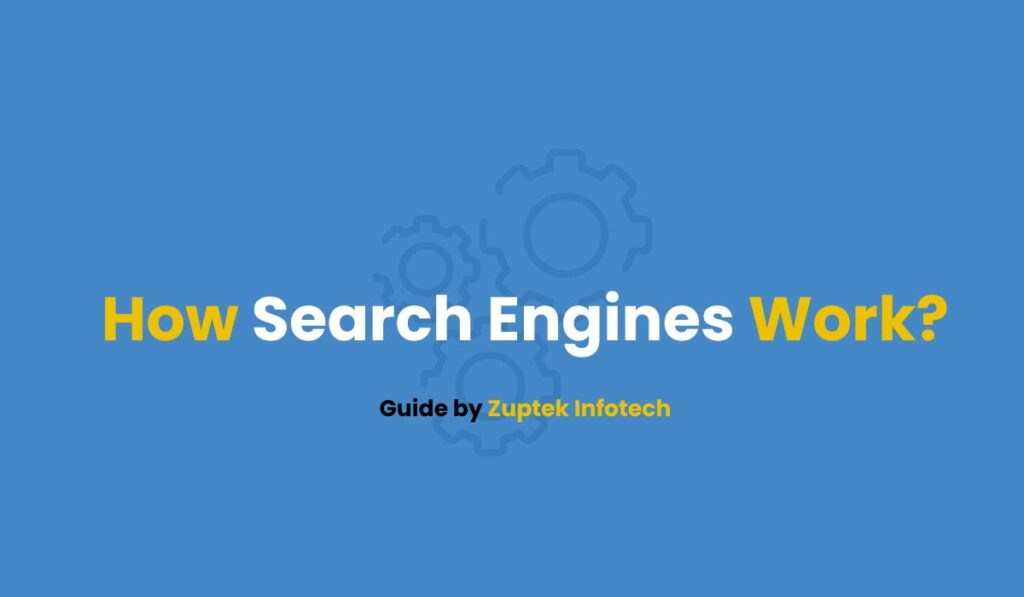Contents
- 1 Understanding Google Core Updates: The Foundation of Search Algorithm Changes
- 2 Decoding the Google March 2025 Core Update: A Closer Look at the Latest Changes
- 3 How the March 2025 Update Impacts Search Ranking Factors: Key Areas for Beginners to Focus On
- 4 The Focus on Surfacing More Creator Content: What This Means for New and Smaller Websites
- 5 Actionable Strategies: Simple Steps to Adapt to the March 2025 Core Update
- 6 What to Do If Your Website is Impacted: A Beginner’s Guide to Understanding Ranking Fluctuations
- 7 Frequently Asked Questions (FAQs) About Google Core Updates and the March 2025 Update
- 8 Conclusion: Building a Strong Foundation with User-Focused Content
Just when you thought you were getting the hang of SEO, Google introduces another update. The March 2025 Core Update is here, and while it might sound complex, understanding it is essential for your website’s visibility and growth. This guide will break down what this update means for you, the beginner, and provide simple steps to ensure your website is well-prepared. Announced around March 13, 2025, this update, like its predecessors, is designed to refine Google’s search algorithm to better serve relevant and satisfying content to users.
Typically, these core updates take about two weeks to fully roll out across Google’s search systems. Staying informed about such changes is crucial for anyone aiming to improve or maintain their website’s position in search results. This post aims to demystify the Google March 2025 Core Update and equip you with actionable knowledge to navigate its impact.
Understanding Google Core Updates: The Foundation of Search Algorithm Changes
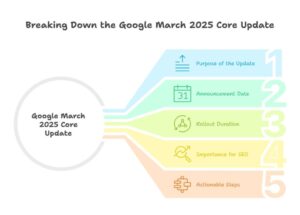
To grasp the significance of the March 2025 update, it’s important to first understand what Google Core Updates are. Think of Google’s search algorithm as the complex system it uses to decide which websites appear at the top of search results. Core updates represent significant and broad changes to this underlying system. These updates aren’t targeted at specific websites but rather involve a fundamental reassessment of how Google evaluates and ranks content across the entire web. The primary goal of these updates is to enhance the overall quality and relevance of the search results provided to users. By refining its evaluation processes, Google strives to ensure that users find the most helpful and trustworthy information in response to their queries. For website owners and content creators, understanding core updates is vital because these changes can lead to notable shifts in search rankings and organic traffic, ultimately affecting website visibility and business outcomes. It’s also important to remember that a drop in rankings following a core update doesn’t automatically mean your website has been penalized; it simply indicates that Google’s updated algorithm might now favor other content for specific searches.
Consider the analogy of a top food recommendations list. Imagine you have a list of your favorite restaurants, but over time, new restaurants open, and your preferences might evolve. When you update your list, some restaurants might move up, and others might move down. The restaurants that moved down aren’t necessarily bad; they just might not align as well with your updated criteria or the emergence of new, compelling options. Similarly, Google’s core updates involve a reassessment of its ranking criteria, and websites that experience a drop in position aren’t necessarily being punished but might be outranked by content that the updated algorithm deems more relevant and satisfying. This distinction between algorithmic adjustments and manual penalties is crucial for beginners. Core updates are about Google refining its system, whereas penalties are typically imposed for specific violations of Google’s webmaster guidelines. Understanding this difference helps website owners focus on making long-term improvements aligned with Google’s evolving standards rather than panicking over perceived punishments.
Decoding the Google March 2025 Core Update: A Closer Look at the Latest Changes
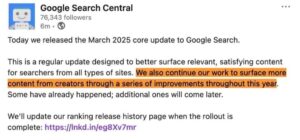
The Google March 2025 Core Update was officially announced on Thursday, March 13, 2025. Google indicated that the rollout of this update could take up to two weeks to be fully implemented. The announcement, often made via Google Search Central’s communication channels, highlighted the update’s focus on “better surface relevant, satisfying content for searchers from all types of sites.” This statement underscores Google’s ongoing commitment to providing users with the most helpful and high-quality information available, regardless of the size or type of website hosting that content. Essentially, Google aims to reward websites that truly meet the needs and expectations of searchers.
A particularly noteworthy aspect of the March 2025 Core Update is the stated emphasis on “surfacing more content from creators.” This suggests that Google is making deliberate adjustments to its algorithms to better identify and elevate original content produced by individuals and smaller entities, rather than solely prioritizing content from large corporations or established publications. This could be a significant development for individual bloggers, independent journalists, niche experts, and small businesses that produce valuable, unique content. Examples of what might be considered “creator content” include personal blogs sharing firsthand experiences, independent websites offering specialized knowledge on specific topics, or individual artists and creators showcasing their work with personal insights and context. While the specific mechanisms Google is implementing to achieve this goal haven’t been explicitly detailed, the overall direction signals a potential opportunity for creators to gain more visibility in search results based on the quality and originality of their work.
The consistent messaging from Google regarding “relevant, satisfying content” reinforces a fundamental principle of SEO: prioritizing the user experience and providing genuine value. This isn’t a novel concept, but its reiteration in the context of this update underscores its enduring importance. For beginners, this means focusing on creating content that truly addresses user needs and provides comprehensive, accurate, and engaging information. Furthermore, the explicit focus on “creator content” could indeed represent a significant opportunity for those just starting out or operating smaller websites. It suggests a potential shift where the sheer authority of a large domain might not be the only deciding factor in ranking, potentially allowing high-quality, original content from less established sources to gain traction. However, the fact that the specific methods for surfacing creator content remain somewhat vague indicates that this is likely an ongoing process, and website owners should remain attentive to future updates and announcements from Google regarding this initiative.
How the March 2025 Update Impacts Search Ranking Factors: Key Areas for Beginners to Focus On
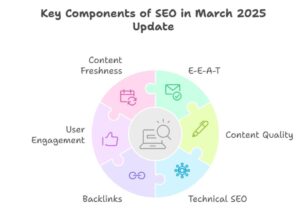
Several key search ranking factors are likely to be influenced by the Google March 2025 Core Update. Understanding these areas will help beginners focus their SEO efforts effectively.
- E-E-A-T (Experience, Expertise, Authoritativeness, Trustworthiness): This set of principles remains a cornerstone of Google’s evaluation of content quality. For beginners, this means demonstrating real-world experience in your content (e.g., a personal account of learning a new skill), showcasing expertise through in-depth knowledge and well-researched information (e.g., a detailed guide on a specific topic within your niche), establishing authoritativeness by becoming a recognized source of information in your field (e.g., getting cited by other reputable websites), and building trustworthiness through a secure website, transparent contact information, and positive user reviews.
- Content Quality: The update reinforces the importance of creating high-quality, helpful, original, and in-depth content that fully addresses the user’s search intent. Content that is thin, generic, or simply rehashes information found elsewhere is less likely to perform well. Focus on providing unique value, such as original research, case studies, or expert analysis.
- Technical SEO: Ensuring your website has a solid technical foundation is crucial for Google to effectively crawl and index your content. Key areas for beginners include optimizing website speed (aim for fast loading times), ensuring mobile-friendliness (your site should work seamlessly on all devices), having a clear site structure and navigation (making it easy for users and search engines to find their way around), and utilizing an XML sitemap (to help Google discover all your pages).
- Backlinks: While the emphasis might be shifting slightly, backlinks (links from other websites to yours) still play a role in indicating the authority and trustworthiness of your site. The focus, however, is increasingly on the quality and relevance of these backlinks rather than just the quantity. Aim to earn backlinks from reputable websites within your niche.
- User Engagement: Google increasingly considers how users interact with your website as a signal of content quality and user satisfaction. Metrics like bounce rate (the percentage of visitors who leave after viewing only one page), dwell time (how long visitors stay on your page), and page views can provide insights into user engagement. Beginners should focus on creating engaging and readable content with clear formatting, visuals, and interactive elements to keep visitors on their site longer.
- Content Freshness: Regularly updating your content, particularly for topics where information evolves rapidly, can positively impact your search rankings. Keeping your content current demonstrates to Google that your website remains a relevant and valuable resource.
The consistent emphasis on E-E-A-T across numerous sources confirms its central role in Google’s ranking system, especially in the context of this update. Beginners should prioritize demonstrating these qualities in their content and on their websites. Furthermore, the potential shift towards valuing contextual relevance and editorial integrity in backlinks suggests that beginners should focus on earning natural, high-quality links rather than pursuing manipulative tactics. The increasing importance of user engagement metrics indicates that creating content that not only ranks well but also keeps users satisfied is crucial. Finally, the stricter stance against low-value content, including poorly executed AI-generated material, serves as a reminder for beginners to prioritize originality and genuine expertise in their content creation efforts.
The Focus on Surfacing More Creator Content: What This Means for New and Smaller Websites
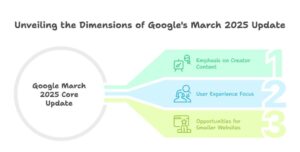
A significant aspect of the March 2025 Core Update is Google’s explicit aim to highlight more content from individual creators and smaller websites. This is potentially good news for beginners who might feel overshadowed by larger, more established websites with higher domain authority. It suggests that if you are producing high-quality, original content that genuinely resonates with users, you may have a greater opportunity to gain visibility in search results, even if your website is relatively new or small.
Examples of the type of “creator content” that Google might prioritize include personal blogs offering unique experiences and insights, niche websites run by experts in specific fields sharing in-depth knowledge, independent journalists or researchers publishing original findings, and artists or creators showcasing their work with personal commentary and context. The key here is often the personal touch, the unique perspective, and the demonstrable expertise of the content creator. It’s important to remember that while this update aims to elevate creator content, the principles of E-E-A-T still apply. Individual creators will need to showcase their experience and expertise to build trust with their audience and demonstrate their authority within their respective niches.
This focus on creator content hints at a possible evolution in how Google weighs domain authority as a ranking factor. While a strong domain authority will likely remain beneficial, this update suggests that the quality and originality of content, along with the creator’s demonstrable expertise, could become more influential in determining search rankings, potentially creating a more level playing field for newcomers. Furthermore, Google’s recognition of the value in creator content aligns with the broader trend of users increasingly seeking out authentic voices and niche expertise online, as evidenced by the popularity of platforms like TikTok. This indicates that Google is adapting its algorithms to better reflect these changing content consumption patterns.
Actionable Strategies: Simple Steps to Adapt to the March 2025 Core Update
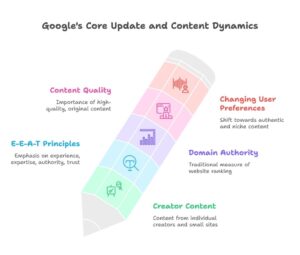
Adapting to the Google March 2025 Core Update doesn’t require complex technical maneuvers. Here are some straightforward strategies that beginners can implement:
- Focus on High-Quality Content: Prioritize creating valuable, informative, original, and engaging content that thoroughly answers user queries.
- Improve E-E-A-T: Clearly showcase your experience and expertise, build authority in your niche, and ensure your website is trustworthy. This could involve adding detailed author bios, citing credible sources, and ensuring your website has a secure connection (HTTPS).
- Optimize Technical SEO and User Experience: Make sure your website is fast, mobile-friendly, easy to navigate, and free of technical errors. Pay close attention to Core Web Vitals, particularly Interaction to Next Paint (INP), which measures responsiveness.
- Build Quality Backlinks: Focus on earning relevant and authoritative backlinks from other reputable websites through genuine outreach and by creating content that others want to link to.
- Maintain Content Freshness: Regularly review and update your existing content to ensure its accuracy and relevance.
The emphasis on Core Web Vitals, especially INP, highlights the growing importance of user experience beyond just page loading speed. Beginners should strive to create websites that not only load quickly but also respond smoothly and promptly to user interactions. Additionally, the focus on earning quality backlinks through genuine methods reinforces the idea that building relationships and creating valuable content are more effective long-term strategies than pursuing low-quality link-building tactics.
What to Do If Your Website is Impacted: A Beginner’s Guide to Understanding Ranking Fluctuations
If you notice a drop in your website’s rankings after the March 2025 Core Update, it’s important not to panic. Remember that a fluctuation in rankings isn’t always a sign of a penalty. It could simply mean that Google’s algorithm now finds other content to be more relevant or satisfying for certain search queries.
The first step is to monitor your website’s traffic and keyword rankings in Google Search Console and Google Analytics to identify the extent of any decline. Avoid making drastic and immediate changes to your website. Instead, focus on long-term improvements by revisiting Google’s guidelines for creating helpful, reliable, people-first content. Review your content to ensure it is high-quality, accurate, and truly meets the needs of your audience. While some recovery in rankings might occur between core updates, significant improvements are often more visible after subsequent updates. However, it’s also important to acknowledge that not all websites that experience a drop in rankings will fully recover. The search landscape is constantly evolving, and sometimes content may become less relevant over time.
The advice to focus on long-term improvements aligned with Google’s guidelines underscores that SEO is an ongoing process. Beginners should adopt a sustainable approach rather than seeking quick fixes. Furthermore, understanding that not all sites will fully recover helps manage expectations and encourages a continuous effort to adapt and improve.
Frequently Asked Questions (FAQs) About Google Core Updates and the March 2025 Update
- What is a Google Core Update? A: A Google Core Update is a significant change to Google’s search algorithm designed to improve the quality and relevance of search results.
- How often do core updates happen? A: Google typically releases a few core updates each year. In 2024, for example, there were core updates in March, August, November, and December.
- What should I do if my rankings drop? A: Don’t panic. Monitor your analytics, review your content for quality and helpfulness, and focus on making long-term improvements based on Google’s guidelines.
- How long does a core update rollout take? A: The rollout for a core update usually takes around one to two weeks to fully complete.
- Does this update target specific types of websites? A: No, core updates are broad and aim to improve the overall quality of search results. They don’t target specific niches or types of websites.
- Will my rankings recover after the update is complete? A: It’s possible to see some recovery, especially if you make significant improvements to your content and website based on Google’s recommendations. However, Google has also indicated that not all sites will fully recover.
The historical data on the frequency of core updates highlights that these are regular occurrences, emphasizing the need for beginners to view adapting to algorithm changes as an ongoing aspect of SEO.
Conclusion: Building a Strong Foundation with User-Focused Content
The Google March 2025 Core Update, while it might seem complex at first glance, ultimately reinforces a fundamental principle of SEO: prioritize your users. By focusing on creating high-quality, helpful content, emphasizing E-E-A-T, ensuring a great user experience, and building a solid technical foundation, you’ll be well-positioned to navigate this and future updates. Think of this update not as a threat, but as an opportunity to refine your website and content, ultimately making it more valuable to your visitors. SEO is a continuous journey, and by focusing on these core principles, you’ll build a strong foundation for long-term success in Google’s search results. The consistent emphasis on creating content with the user in mind remains the most reliable strategy for achieving sustainable SEO success.
Hi, I’m Mitu Chowdhary — an SEO enthusiast turned expert who genuinely enjoys helping people understand how search engines work. With this Blog, I focus on making SEO feel less overwhelming and more approachable for anyone who wants to learn — whether you’re just getting started or running a business and trying to grow online.
I write for beginners, small business owners, service providers — anyone curious about how to get found on Google and build a real online presence. My goal is to break down SEO into simple, practical steps that you can actually use, without the confusing technical jargon.
Every post I share comes from a place of wanting to help — not just to explain what SEO is, but to show you how to make it work for you. If something doesn’t make sense, I want this blog to be the place where it finally clicks.
I believe good SEO is about clarity, consistency, and a bit of creativity — and that’s exactly what I try to bring to every article here.
Thanks for stopping by. I hope you find something helpful here!

